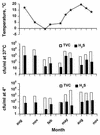Occurrence of Shewanella algae in Danish coastal water and effects of water temperature and culture conditions on its survival
- PMID: 10473392
- PMCID: PMC99717
- DOI: 10.1128/AEM.65.9.3896-3900.1999
Occurrence of Shewanella algae in Danish coastal water and effects of water temperature and culture conditions on its survival
Abstract
The marine bacterium Shewanella algae, which was identified as the cause of human cases of bacteremia and ear infections in Denmark in the summers of 1994 and 1995, was detected in seawater only during the months (July, August, September, and October) when the water temperature was above 13 degrees C. The bacterium is a typical mesophilic organism, and model experiments were conducted to elucidate the fate of the organism under cold and nutrient-limited conditions. The culturable count of S. algae decreased rapidly from 10(7) CFU/ml to 10(1) CFU/ml in approximately 1 month when cells grown at 20 to 37 degrees C were exposed to cold (2 degrees C) seawater. In contrast, the culturable count of cells exposed to warmer seawater (10 to 25 degrees C) remained constant. Allowing the bacterium a transition period in seawater at 20 degrees C before exposure to the 2 degrees C seawater resulted in 100% survival over a period of 1 to 2 months. The cold protection offered by this transition (starvation) probably explains the ability of the organism to persist in Danish seawater despite very low (0 to 1 degrees C) winter water temperatures. The culturable counts of samples kept at 2 degrees C increased to 10(5) to 10(7) CFU/ml at room temperature. Most probable number analysis showed this result to be due to regrowth rather than resuscitation. It was hypothesized that S. algae would survive cold exposure better if in the biofilm state; however, culturable counts from S. algae biofilms decreased as rapidly as did counts of planktonic cells.
Figures




References
-
- Bockemühl J, Roch K, Wohlers B, Aleksic V, Aleksic S, Wokatsch R. Seasonal distribution of facultatively enteropathogenic vibrios (Vibrio cholerae, Vibrio mimicus, Vibrio parahaemolyticus) in the freshwater of the Elbe River at Hamburg. J Appl Bacteriol. 1986;60:435–442. - PubMed
Publication types
MeSH terms
Substances
LinkOut - more resources
Full Text Sources

